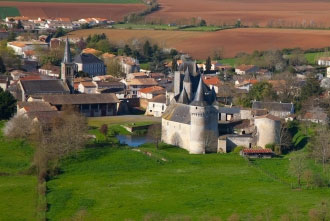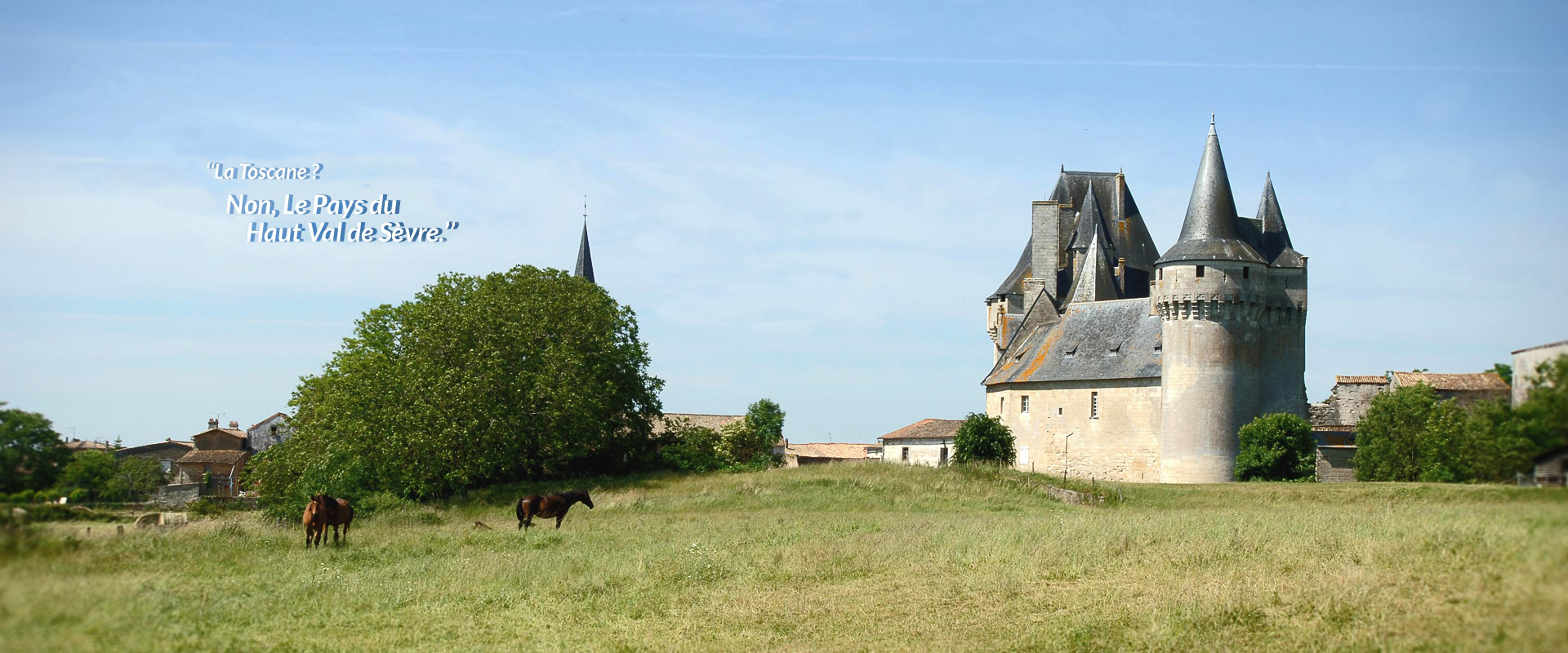Climate: This region has the sunniest weather on the Atlantic Coast, averaging 2000 to 2250sunny hours per year .
Nearby Tourist Attractions: Locally : Marais Poitevin is located 10 km to the south. Poiters, home of Futuroscope, is 65 km northeast, and the historical town of Rochelle is 82 km west of the castle. Other nearby attractions include the Puy du Fou, the Zoorama, and the European Forest of Chizé.
Local Attractions:The Château de Cherveux is located in the countryside known as "Haut Val de Sèvres".
The beautiful small lake, Cherveux-St-Christophe is located just 2 km from the castle where visitors can enjoy tennis, swimming, and camping. An equestrian center, a forest (La Chapelle Baton), and Golf du Petit Chene are located nearby also.
Historical Sites: The castle is situated near Roman art treasures. Melle, a stage on the path of St-Jacques of Compostelle, Poitiers, Celle sur Belle... Of the Tumulus of Bougon dating to the Neolithic Period, mines of silver of the Francs kings of Celle sur Belle, of the Gallo-Roman site of Sanxay, of other castles,: Saint-Gelais, Niort and its dungeon, Salbart, St-Loup sur Thouet...
Cuisine: The food of Poitou-Charentes is excellent. Visitors will find numerous specialties in this region, including Pineau, the wines of the High-Poitou, oysters of Marennes-Oléron, mussels of Bouchot, Farcis Poitevin, melons of the High-Poitou, "Lumas Sauce", the lamb of the High-Poitou, Charentes-Poitou butter, the kitchen of the Marais Poitevin, delicate goat cheeses, the famous tourteau fromagé, and angelic, brandy.
Cultural Events: Every year, many festivals take place in the area. Some of the best include The Festival of Cartoons in Angoulême, The International Folklore of Confolans, The Police Movie in Cognac, of the spring musicals in Poitiers, the Musical Academies of Saintes, the Grand Pavois and the Francofolies of la Rochelle.
Welcome to Cherveux
Between "Plaine and Gatine"
Isolated in the middle of a fertile plain on a verdant plateau
rises the village of Cherveux where the view embraces the most distant
horizon. (1200 inhabitants with his trades : bar-restaurant-pizza to carry
away-videoclub, bakery-pastry, grocery store, pharmacy, taxicab) To the
south , a vast plain undulates towards large horizons, extending to the
Niortaise plain which was once part of the sea ( the soil is chalky, permeable
and excellent for growing grains) . Stone quarries are numerous in
this region.The land is rich in fossils : ammonites, "rostres of Bélemnites".
Farther to the south about 20 kms, one discovers the " Poitevin marsh ".
To the north, one sees the gâtine, with more accentuated undulations
and natural prairies surrounded by thick hedges. Here, the argilo-sandy
soil is more compact and more impervious. It is favorable for cattle
breeding Origins of Cherveux Prehistoric period : Flint tools (bifaces-knife-scraper-ax-tips
of arrows) buried in the plain testify that the place was inhabited during
prehistoric times. Roman period : Some vestiges attest that the Romans
occupied some places The name of Cherveux : is of Celtic origin, what
would indicate that the area originated at a very ancient date. This village
was first known under the name of Carvium in 1100, then, a century later
as Cherveox and Cheveras until the fifteenth century. It then became
Cherveaux, then, by 1603, Chevreoux and later, Cherveus. Then, it
was called St Pierre of Cherveux into the Eighteenth century before being
only simply Cherveux. Its name would come from hemp (in "local patois":
chorbe or chorve). Since this plant was very abundant in this region,
many people made their livings as weavers and manufacturer of rope). Cherveux
probably owes its existence to a monastery that was settled close to the
" motte féodale " that was later to become the powerful fortress of the
Lusignans. Monks that lived in it were driven out during the wars
that ravaged the Poitou. The monastery has been destroyed and on the site
now stands a church that rises on the remains of the ancient monastery,
known as St-Pierre's de Poitiers cathedral. Stones that have been
found in the church graveyard are shaped like those of Civaux and Nanteuil. In
a stable of the castle farm, there is a window that leads to the ruins
of the ancient monestary. Some places around Cherveux called Maurie and
the Raberie (spelled before Araberie) remind us of the passage of the Maure
and the Arabian.
Bibliographie Madame Gaboreau (E) : histoire du château et de Cherveux
: "Glanes sur Cherveux" 1978
Office du tourisme haut val de Sèvres

